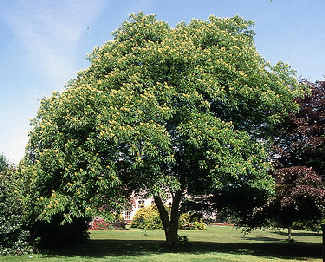Buckeye Trees
Aesculus glabra Ohio Buckeye
Zones: 4-7
Sun: Full sun to part shade
Height: 40-75’ up to 100’
Spread: 35-50’
Shape: Rounded or domed dense crown, outer branches often droop and have curled up tips
Growth Rate: Moderate
Soil Preference: Prefers consistently moist well drained, cultivated soil. Somewhat adaptable. Prefers slightly acidic soil.
Moisture: Average to high moisture requirements
Foliage: Dark green, paler underside, 5 leaflet, coarse texture. Turns yellow or orange in Fall
Blooms: 4-7” erect, full clusters of light yellow flowers in very early spring
Fruit: 1 - 1 1/2” round, brown prickly capsules in fall, slightly poisonous
Ohio Buckeye leafs out very early in spring, early enough that the leaves are susceptible to frost kill. Blooms also appear very early, as early as March in warmer climates, May in the north. The blooms are a light greenish yellow borne in upright branched clusters. Fruit resembles a “buck’s eye”, and begins producing in about 8 years. Crushing the leaves or twigs of the Buckeye produces a rather foul odor, giving it the nickname of the stinking buck-eye.
The Ohio Buckeye prefers moist soil and is often found along river bottoms and streams. Where growing in dry conditions, the Ohio Buckeye will be small and more shrub like. In ordinary suburban conditions the trees generally reach 40-60’ high with a 35-45’ spread, but can vary dramatically depending on soil and moisture conditions. In hot dry periods particularly in urban areas where pollution is also an issue, the foliage will exhibit leaf scorch. The soft wood and structure of the tree seems to be somewhat stronger than the Horse Chestnut, rarely sustaining damage through heavy snow and wind in the North. The trunk also seems to resist sunscald. Ohio Buckeye develops a strong tap root in its’ first year, so it very difficult to move after the first season.
Aesculus flava octandra Yellow Buckeye
Zones: 3-8
Sun: Full sun
Height: 50-70’ up to 100’
Spread: 35-40’
Shape: Upright and oval to spreading dense crown.
Growth Rate: Slow when young, fast as it matures, 12-18” per year.
Soil Preference: Prefers consistently moist, well drained, deeply cultivated soil. Prefers slightly acidic soil. Somewhat adaptable,
Moisture: Average to high moisture requirements
Foliage: Dark green, 5 leaflet, coarse texture. Turns yellow or orange in Fall
Blooms: 6” erect, full clusters of creamy yellow to yellow green flowers in late spring
Fruit: 2 - 2 1/2” smooth pear shaped capsules, tan brown.
The Yellow Buckeye has much less trouble with leaf scorch than other buckeyes, with a pleasant yellow to orange fall foliage color. The yellow blooms come later than other buckeyes, not appearing until May or even June. The fruit matures and breaks open to expose the brown nuts with a prominent white “buck eye” in September or October. Flowering and fruiting may take up to ten years. The tree prefers full sun for best development and will do fine in heavy clay soils, not quite as well in sandy soil. The root system is sparsely branched and needs deep soil with some room to spread. Makes an excellent large property or park tree with ornamental blooms, casting a dense shade. It may be difficult to locate since it does not reproduce well from seed and should be planted container or ball and burlap. Overall the Yellow Buckeye is the most tolerant and adaptable variety of the Buckeye and Horse Chestnut trees. However, they are difficult to distinguish from the Ohio Buckeye other than leaf scorch problems and the difference in fruit characteristics.
Aesculus pavia Dwarf Red Buckeye
Zones: 4-9
Sun: Full sun to part shade
Height: 10-20’
Spread: 10-20’
Shape: Rounded dense crown
Growth Rate: Slow to moderate
Soil Preference: Prefers moist well drained, deeply cultivated soil. Somewhat adaptable.
Moisture: Average to high moisture requirements
Foliage: Large leaves are drooping and dark green, 5 leaflet, coarse texture.
Blooms: 6-9” erect, loose clusters of carmine red flowers in late spring to early summer.
Fruit: Leathery capsules in fall.
The Dwarf Red Buckeye is one of the first to open leaves in spring, a month ahead of oaks and maples. But the leaves are also the first to drop in autumn, with no color change. The early blooms are one of the first food sources for hummingbirds. But the early blooms may be susceptible to late frosts, particularly in zone 4. Dwarf Red Buckeye will bloom when the tree is still very young. Plant in full to mostly sun for best flowering. The small tree is clump forming and can be grown as a large shrub or multi-trunk tree. Prune lower lateral branches to maintain a tree form. Excellent small ornamental tree for a woodland garden or near a patio.
Aesculus neglecta Dwarf Yellow Buckeye ‘Erythroblastos’
Zones: 5-8
Sun: Full sun to part shade
Height: 30’
Spread: 25’
Shape: Rounded or pyramidal crown
Growth Rate: Slow to moderate
Soil Preference: Prefers moist well drained, deeply cultivated soil. Somewhat adaptable. Prefers slightly acidic soil.
Moisture: Average to high moisture requirements
Foliage: Leaves open pink, turn cream green, then medium green, 5 leaflet, coarse texture. Turns yellow or orange in Fall
Blooms: 4” erect, full clusters yellow flowers in spring flushing with red by mid summer
Fruit: Smooth capsules in fall.
The Dwarf Buckeye is beautiful in spring when the creamy pink leaves tinged with orange begin to open. When grown in part shade, the lovely leaf color may last a bit longer. The flowers are pale yellow but not nearly as showy as any of the Buckeyes or Horse Chestnuts. However the fall color is lovely, much like it’s parent the Yellow Buckeye. The Dwarf Buckeye reaches mature size in ten to twenty years, taking several years to develop flower and fruit. ‘Erythroblastos’ is also referred to as the Sunrise Horse Chestnut or Dwarf Yellow Buckeye or Dwarf Horse Chestnut. There are several new dwarf cultivars of dwarf Buckeyes and Horse Chestnuts, but they are not easy to find









